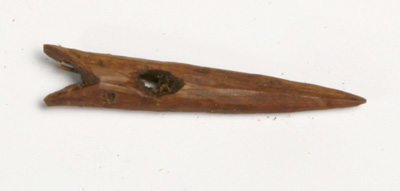 The Tunit made our country habitable. They built the line of boulder cairns that guide caribou to the river-crossings where they can be ambushed by hunters, and they furnished the rivers with fish-weirs. An Inuit story, from Ancient People of the Arctic by Dr. Robert McGhee
The Tunit made our country habitable. They built the line of boulder cairns that guide caribou to the river-crossings where they can be ambushed by hunters, and they furnished the rivers with fish-weirs. An Inuit story, from Ancient People of the Arctic by Dr. Robert McGhee
Today archaeologists believe that the Tunit, who are mentioned in Inuit stories, flourished in the arctic during ancient times, vanishing around the 14th century AD.
Archaeologists first encountered their remains in 1925 at a place called Cape Dorset on Baffin Island. They gave them the name Dorset culture, a term that is still used today.
The Dorset developed special technologies that allowed them to survive in the harsh arctic environment. They used harpoons and lances to hunt down walrus and other animals. They constructed semi-subterranean houses made of stone and sod, to shelter themselves from the elements. To improve their tool repertoire, they obtained pure iron from meteorite remains at Cape York in Greenland pounding them with heavy rocks to remove flakes that could then be hammered into an edge.
Recent research, conducted by Dr. Patricia Sutherland, suggests that the Dorset even developed a trading relationship with the Norse who appeared in the Arctic around AD 1000.
Why they vanished is a mystery. Climate change, which warmed the arctic, may have been a culprit. An eastward migration of the Thule (ancestors of the Inuit), around AD 1000, could also have played a role. It has even been suggested that the Dorset succumbed to diseases brought to North America by the Norse. A fate that would be shared by other Native American groups hundreds of years later, after Columbus landed in the New World in 1492.
An ancient maskette
The Nuvuk Islands lie off the northern tip of Quebec, close to the modern day settlement of Ivujivik. A team of archaeologists from the Avataq Cultural Institute and Laval University, including nearly a dozen local high school students learning about archaeology, have been exploring the islands.
They have uncovered two Dorset houses, each of them nine meters long,that date to somewhere between 1,500 and 800 years ago. Constructed of stone and sod they were sunk partly into the ground to help insulate them.
 One of the most intriguing artefacts theyve found is a5 centimetre long ivory maskette thatmay have been used by a shaman a person who would have connected the people with the spiritual world. Its the first complete maskette found in northern Quebec (an area also known as Nunavik) in more than 50 years.
One of the most intriguing artefacts theyve found is a5 centimetre long ivory maskette thatmay have been used by a shaman a person who would have connected the people with the spiritual world. Its the first complete maskette found in northern Quebec (an area also known as Nunavik) in more than 50 years.
Its quite possible that it had some kind of shamanic connection, there was some kind of religious or spiritual side to it, said archaeologist Susan Lofthouse, in an interview with Heritage Key.
It has a holenear the topwhich means itprobably would have been worn like an amulet. It was cut out of walrus ivory and crafted with great skill as shown by the small details.
Two nostrils (representing the nose) are cut into the centre. Mouth, ears and eyes were also depicted. The maskette has an x-ray motif lines that run across it. Its something commonly seen in art from this time period.
A lady from Nunavik suggested to me that the lines represent tattoos indicating that the face represents a woman, wrote Lofthouse in a recent paper.
There is more evidence that this maskette represents a woman.
At the top of the mask there is a round shape that looks like a bun. Historically Inuit women would wear top knots on top of their heads, said Lofthouse. Their hair would be kind of tied up into a bun on top of their head it looks quite similar to that.
So couldthis maskettehave been used by a female shaman? Traditionally shamans were more often men (however) there have been accounts of female shamans, said Lofthouse. It could have been related to magic that pertains to women.
Hunting walrus in the open ocean
 To obtain the ivory for the maskette, the people would have hunted walrus going out on the Arctic Ocean to do so. As far as we know the Dorset only had small skin boats, like kayaks, Lofthouse said. Definitely it could have been dangerous.
To obtain the ivory for the maskette, the people would have hunted walrus going out on the Arctic Ocean to do so. As far as we know the Dorset only had small skin boats, like kayaks, Lofthouse said. Definitely it could have been dangerous.
The walrus would have been used for more than its ivory. It would have been consumed along with other animals such as seal, caribou and seabird. Bone remains from all these species have been found on the site.
To aid in hunting, the Dorset developed harpoons that would have been used to kill and bring in the animals.
So important was the harpoon that the Dorset even created a miniaturized version of them, examples of which have been found on site. Only a few centimetres long, these tiny figures were definitely not for practical use, said Lofthouse. Rather they probably were something like hunting amulets for good luck.